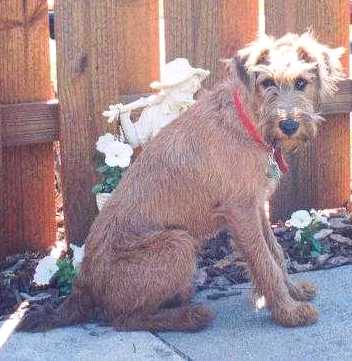
Cooper the Irish Terrier as a puppy at 6 months old
ahy-rish ter-ee-er 
The Irish Terrier is a medium-sized dog that is somewhat longer than it is tall. The long head is flat between the ears and is in good proportion to the rest of the body. It has a slight stop that is not very noticeable unless you view the dog from the side. The nose is black. The teeth meet in a scissors or level bite. The small eyes are dark brown with bushy eyebrows. The ears are V-shaped, fold forward toward the outside corners of the eyes, and have darker, shorter hairs than the rest of the body. The ears of an Irish Terrier sometimes require "training." The ears get glued to the top of their heads so that they form the correct shape as the cartilage fills in. Not all dogs require this, and it's definitely not necessary if you're not going to show the dog. A special non-toxic leather glue called tear-mender is used. The front legs are straight, long and muscular. The tail is docked taking off about 1/4th the natural length. Note: docking tails is illegal in most parts of Europe. The thick, rough-looking, wiry coat lies close to the body and comes in solid bright red, golden red, red wheaten, or wheaten. The coat has a softer undercoat. The dog has long whiskers and a bearded muzzle, sometimes with a small patch of white on the chest. Puppies are sometimes born black, but later change colors.
The Irish Terrier is courageous, energetic and loyal, often affectionately called "daredevils" by their fanciers. Sweet with their families, they are entertaining companions. The Irish Terrier is a good friend for active children, loving a good play. Bold, inquisitive and ready for action and adventure. Intelligent, they are very trainable. They have a strong protective instinct and therefore need dominant owners. If this breed senses an owner has a meek side to them it will become willful, as the dog will believe he needs to be in charge. Can be quite a handful. Train firmly, starting when the dog is a puppy, providing rules the dog must follow and limits to what he is and is not allowed to do. Be calm, but stern and always consistent. Socialized this breed well. May not get along with other dogs if the owners are not on top of communicating that the dog is not in charge and that fighting is an unwanted behavior. This hunting terrier should not be trusted with non-canine pets. They can be difficult to housebreak. The Irish Terrier likes to dig, explore and chase anything that moves. Do not let it run free unless it is in a safe area.
Height: about 18 inches (43 cm)
Weight: 25 - 27 pounds (11 - 12 kg)
This is a very healthy breed and is not prone to any major hereditary disorders.
The Irish Terrier will do okay in an apartment if it is sufficiently exercised; a small yard will do. If given sufficient exercise, it is surprisingly well-mannered and dignified indoors.
Since Irish Terriers were bred for active work, these dogs need plenty of regular exercise. They need at least a daily long, brisk walk, where the dog is made to heel beside or behind the human holding the lead. Do not let this terrier walk in front, as in a dog's mind the leader leads the way, and that leader needs to be the human.
About 12-15 years
About 4 to 6 puppies
The hard double coat is easy to groom and rarely sheds. Brush regularly with a stiff bristle brush and remove the dead hair with a fine-tooth comb. Bathe only when necessary. Irish Terriers are also supposed to be hand-stripped/ hand-plucked twice a year (just like an Airedale). Dogs that compete in dog shows need more extensive grooming. Sheds little hair and some people with allergies are able to tolerate this breed.
It is believed that the Irish Terrier is one of the oldest terrier breeds. The breed is thought to be two thousand years old, but the earliest images we have of it is in a painting from the 1700s. The exact breeds it descended from are unknown, but they were originally found in Country Cork, Ireland. The Irish Terrier was used to hunt den animals such as otter and water rats, and as a retriever and wartime messenger. The Irish Terrier was recognized by the AKC in 1885 and a United States' breed club was started in 1896. Some of the Irish Terrier's talents include: hunting, tracking, retrieving, ratter, watchdog, guarding, police work and military work.
Terrier, AKC Terrier
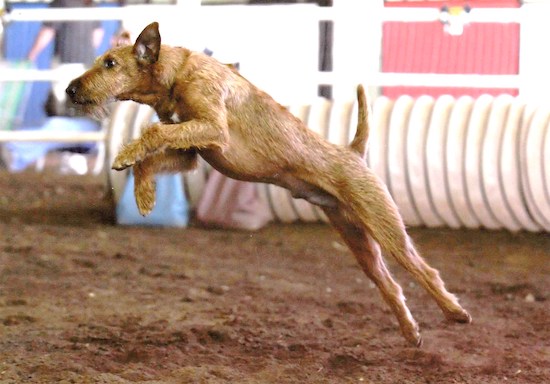
"This is Seamus or "Happy Dude" jumping at an agility trial. Seamus loves to run and jump and is also training in obedience and has his Rally Excellent title. Irish Terriers need lots of socialization and obedience classes are a must. They are a healthy breed without the hip, eye and ear problems you hear about in other breeds. We follow Cesar Millan’s calm, assertive training methods, and definitely are pack leaders. Lots of exercise is a must—we take daily walks of at least an hour twice a day."
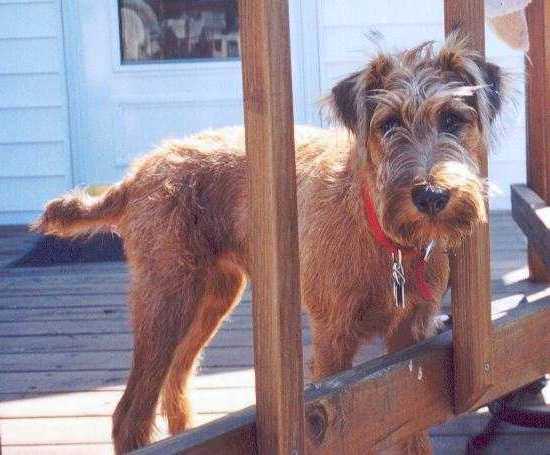
6-month-old Cooper the Irish Terrier looking through the deck rails
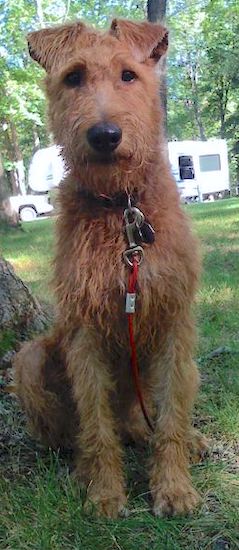
"This is Quigley, our Irish Terrier. Irish Terriers are very smart and they pick up tricks and routines very, very quickly. They are a little hard to housebreak, though.... Also, they never ever forget anything. They need to have puzzles and things to work on around the house. We play hide-and-seek with her toys. They need LOTS of socialization with other dogs when they are young. Quigley loves to play with other dogs. We let Quigley grow bushy during the winter and she doesn't really shed very much hair, but in the summertime we pluck her down and then she doesn't shed at all. We never have and never plan on showing Quigley. Her hair isn't dense enough and it's a bit bushy (it doesn't lie flat). Her name Quigley actually means "the one with the unruly hair." She also is a bit big for the breed standard and she has a curl to her tail. But other than that she's a good example of the breed. This picture is of Quigley's ears post glue, while camping."
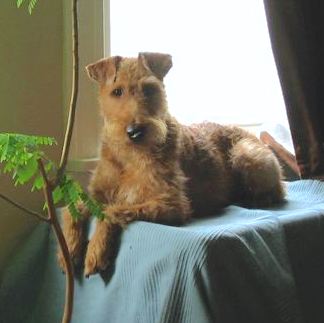
Quigley the Irish Terrier
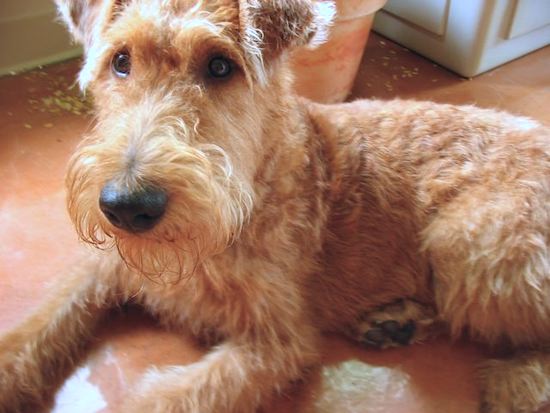
Quigley the Irish Terrier chilling out at home
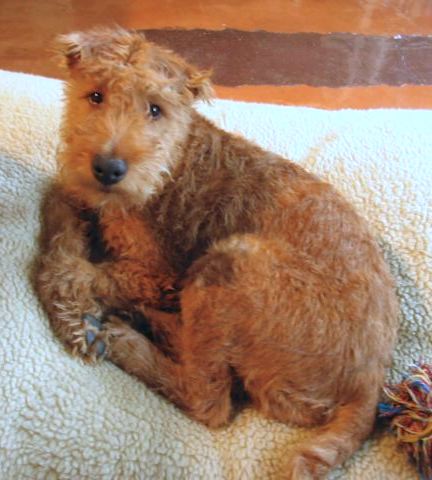
Quigley the Irish with her ears glued
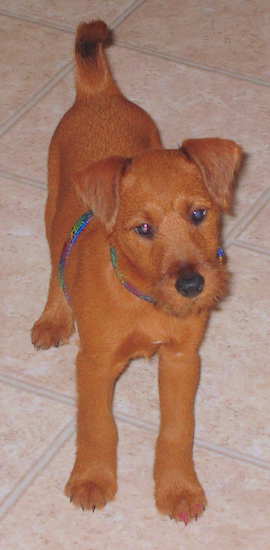
Grogan the Irish Terrier as a puppy at 9 weeks old
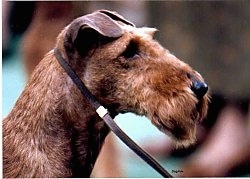
Photo courtesy of Baystone Irish Terriers
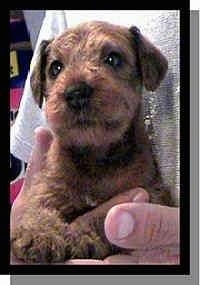
This is Okerry's Rock of the Cashel aka Rocky as a small pup.
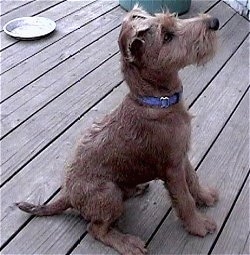
Rocky the Irish Terrier